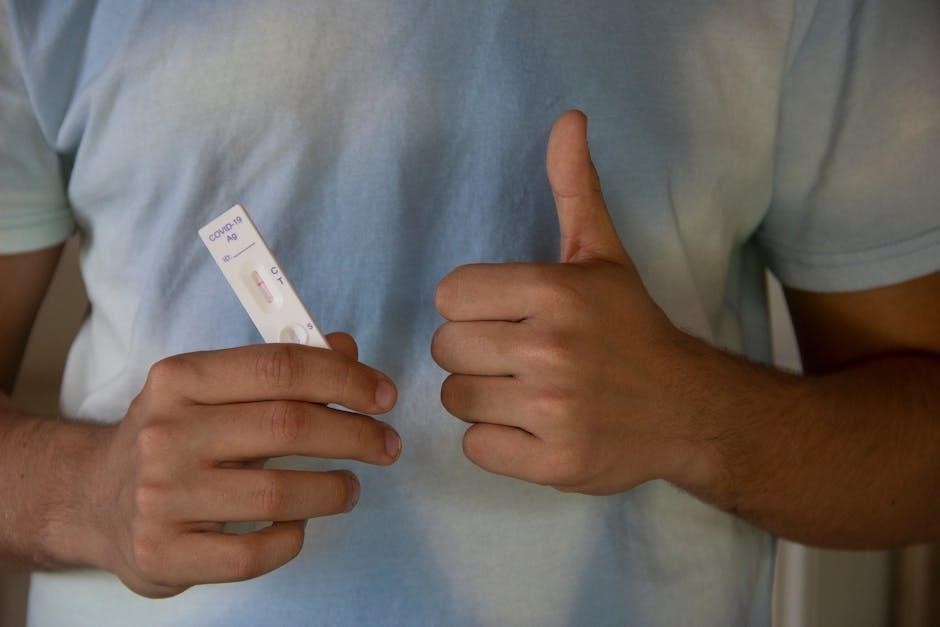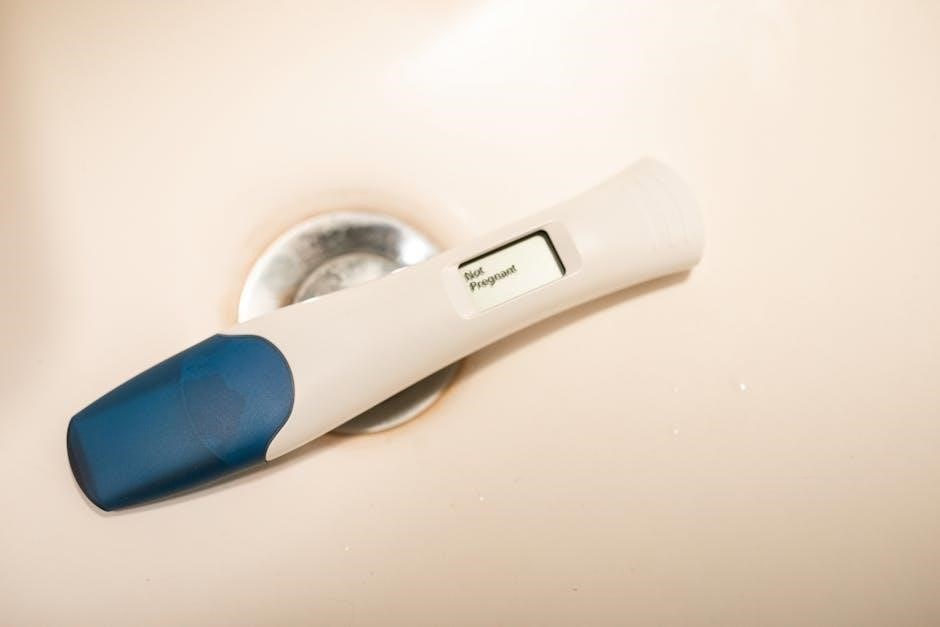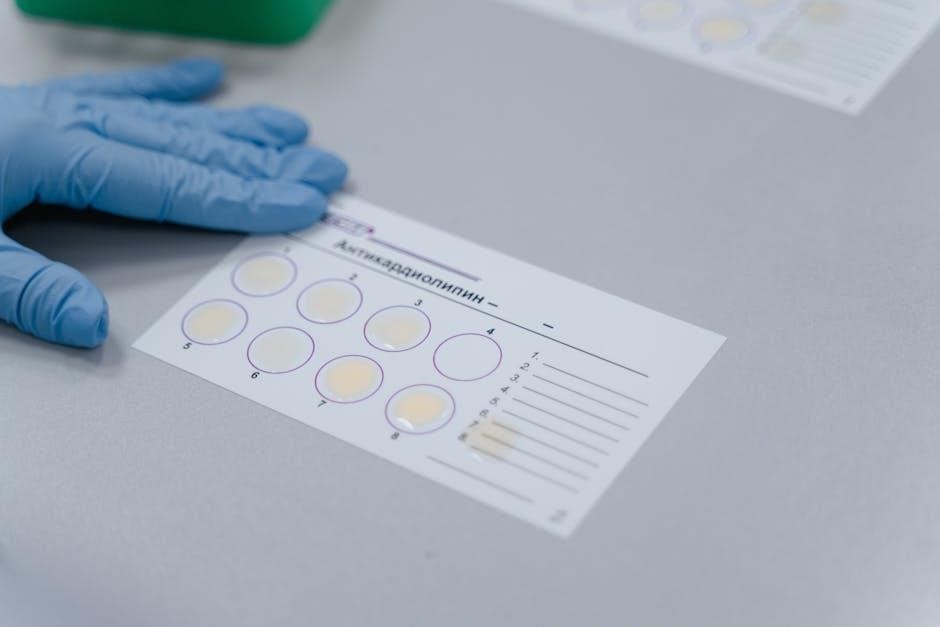Understanding Negative STD Test Results
A negative STD test result indicates no detectable infection, but accuracy depends on timing, testing methods, and individual factors․ Always consult healthcare providers for precise interpretation and guidance․
Definition of Negative STD Test Results
A negative STD test result indicates that no infection was detected for the specific sexually transmitted disease being tested․ For example, a range below 0․90 in Herpes Simplex-2 tests or the absence of antibodies in Syphilis tests signifies a negative result․ This means the individual does not have the infection at the time of testing․ However, it is important to note that no test is 100% accurate, and factors like testing timing, method, or sample quality can influence results․ Always consult a healthcare provider for accurate interpretation․
What Do Negative Results Indicate?
Negative STD test results indicate that no infection was detected for the specific STD tested․ For example, a negative Chlamydia or Gonorrhea NAA test means no bacterial DNA was found․ Similarly, a negative HIV or Syphilis test suggests no antibodies or antigens were present․ However, negative results don’t always rule out infection due to factors like testing too early (window period) or test limitations․ Always interpret results with a healthcare provider to ensure accuracy and appropriate next steps․ Testing methods and timing play crucial roles in result reliability․
Importance of Understanding Test Results
Understanding negative STD test results is crucial for personal health and preventing transmission․ A negative result can provide peace of mind and confirm effective treatment․ However, false negatives may occur, especially during the infection window period․ Accurate interpretation ensures proper precautions and avoids misinformation․ Clear communication with partners and healthcare providers is essential for maintaining sexual health․ Misunderstanding results can lead to risky behaviors or delayed treatment․ Therefore, seeking professional guidance is vital to ensure accurate interpretation and appropriate follow-up actions based on test outcomes․ This fosters better health management and disease prevention strategies․

Accuracy of Negative STD Test Results
Negative STD test results are generally reliable but can be affected by factors like testing timing and methods․ False negatives may occur due to the infection window period․
False Negative Results: What You Need to Know
False negative STD test results occur when an infection is present but not detected․ This can happen due to early testing before antibodies develop, improper sample collection, or test limitations․ For HIV, the window period is crucial, as antibodies may not appear until weeks after exposure․ Similarly, for herpes, swabs must be taken during an active outbreak for accuracy․ Understanding these factors is essential for interpreting results and ensuring reliable testing outcomes․

Factors Affecting Test Accuracy
Several factors influence the accuracy of STD test results․ Timing is critical; testing too early may miss infections․ Sample collection quality, such as swabs or blood draws, impacts outcomes․ Test type, like antibody vs․ antigen tests, varies in sensitivity․ Patient health conditions and medications can also affect results․ Ensuring proper test administration and adhering to laboratory guidelines are vital for reliable outcomes․ Understanding these factors helps interpret results accurately and makes informed health decisions․

Role of Testing Methods in Result Accuracy
Different testing methods play a crucial role in the accuracy of STD results․ Nucleic Acid Amplification Tests (NAATs) are highly sensitive for detecting Chlamydia and Gonorrhea․ Serological tests, like Western Blot for HIV, detect antibodies, offering accurate long-term infection status․ Rapid tests provide quick results but may have lower sensitivity․ Choosing the right method based on infection type and stage ensures reliable outcomes․ Understanding these methods helps in interpreting negative results and making informed health decisions effectively․

Common STDs and Negative Test Results
STDs like HIV, Chlamydia, and Syphilis can yield negative results due to early testing, low antibodies, or test type limitations․ Understanding each infection’s testing window is crucial․
HIV and Negative Test Results
A negative HIV test result indicates no detectable antibodies or viral load, but accuracy depends on the testing window․ Early testing may yield false negatives; retesting is recommended after the window period․ Understanding test types, such as rapid tests or Western Blot, is essential for accurate interpretation․ Consulting healthcare providers ensures proper guidance and next steps, especially if exposure risks exist․ Regular testing is crucial for maintaining sexual health and preventing transmission․
Chlamydia and Gonorrhea: Understanding Negative Results
A negative Chlamydia or Gonorrhea test result suggests no infection, but accuracy depends on testing timing and methods․ Nucleic Acid Amplification (NAA) tests are highly sensitive, reducing false negatives․ However, early testing may miss infections․ Understanding test types, like RNA TMA, is crucial․ If symptoms persist, retesting is advised․ Consulting healthcare providers ensures accurate interpretation and guidance․ Regular screening is vital for sexual health, especially for high-risk individuals․ Always follow up with a healthcare professional for confirmation and further advice․
Syphilis and Herpes: Interpreting Test Outcomes
A negative syphilis test result, such as anti-treponemal antibody testing, indicates no infection with Treponema pallidum․ Similarly, a negative Herpes Simplex-2 test result (e․g․, below the 0․90 range) suggests no detectable antibodies or antigens․ However, early testing may miss infections during the window period․ False negatives can occur if testing is done too soon after exposure․ If symptoms persist despite a negative result, retesting is recommended․ Consulting a healthcare provider ensures accurate interpretation and appropriate next steps for both conditions․

Implications of Negative STD Test Results
A negative result means no infection was detected, but false negatives can occur․ It’s important to consult healthcare providers for accurate interpretation and guidance, ensuring proper next steps․
When to Consider Retesting
A negative STD test result doesn’t always mean you’re clear, as false negatives can occur․ Retesting is recommended if symptoms persist, exposure timing was too early for detection, or test accuracy is questionable․ Factors like the window period, test sensitivity, and lab procedures can influence results․ If there’s a high-risk exposure or doubt about accuracy, retesting after the recommended waiting period is advised․ Consulting a healthcare provider ensures proper interpretation and guidance for next steps, minimizing the risk of undetected infections․
Discussing Results with Partners

Diskussing negative STD test results with partners is crucial for transparency and trust․ Open communication ensures both parties understand their status and any necessary precautions․ Even with a negative result, discussing the possibility of retesting can provide peace of mind and ensure mutual responsibility for sexual health․ Sharing test results fosters trust and respect, promoting a healthier relationship․ It’s important to approach the conversation with sensitivity and honesty, ensuring both partners feel informed and supported․
Post-Test Precautions and Lifestyle Changes
A negative STD test result is not a free pass for risky behavior․ Safe practices remain essential to prevent future infections․ Even with a negative result, maintain open communication with partners about sexual health and boundaries․ Avoid unprotected intercourse and ensure mutual consent․ Regular testing is still recommended, especially for sexually active individuals․ Adopting healthier lifestyle choices, such as avoiding substance abuse and managing stress, can also contribute to overall well-being․ Remember, a negative result is not a lifetime guarantee—continued vigilance is key․

Obtaining and Interpreting Negative STD Test Results
Access your negative std test results pdf through healthcare providers or labs․ Understand the results by reviewing the report, ensuring clarity on all tested infections and their status․ Editing and sharing options are available online, but always verify accuracy․ Consult reliable organizations for guidance on interpreting and managing your results effectively․
How to Get Tested for STDs
To get tested for STDs, visit a healthcare provider or clinic․ Provide biological samples like blood, urine, or swabs․ Results are often delivered as a negative std test results pdf, detailing each infection’s status․ Ensure tests are conducted after the infection’s window period for accuracy․ Review the PDF report carefully, and consult providers if unsure․ Online platforms offer tools to access, edit, and share results securely․ Regular testing is crucial for maintaining sexual health and preventing undiagnosed infections․
Understanding the PDF Format of Test Results
A negative std test results pdf typically includes the test name, patient details, and clear indicators of negative status․ Results are presented with reference ranges, ensuring clarity․ The PDF format allows easy sharing and storage․ It may also include instructions for interpretation and next steps․ Labs like Labcorp provide detailed reports, making it easier to understand your status․ Always review the document carefully and consult healthcare providers if questions arise about the results or their implications for your health․
Consulting Healthcare Providers for Result Interpretation
Discussing your negative std test results pdf with a healthcare provider ensures accurate interpretation․ They can explain what negative results mean, address concerns, and recommend further testing if needed․ Providers consider factors like test timing and accuracy, offering personalized advice․ This consultation is crucial for understanding your health status and next steps, ensuring peace of mind and proper care․ Don’t hesitate to seek professional guidance to interpret your results effectively and make informed decisions about your health․

Resources and Tools for Managing Negative STD Test Results
Access negative std test results pdf templates and editing tools online for easy management․ Utilize reliable health organizations and platforms like airSlate for secure sharing and professional guidance․
Where to Find STD Test Result Templates
Find negative std test results pdf templates on platforms like airSlate or Labcorp․ Official health organizations and medical labs provide downloadable forms for test results․ Access templates for specific STDs, such as HIV or Chlamydia, through official websites or healthcare portals․ Ensure the documents are medically verified and comply with health standards․ Use these templates to organize and share test outcomes securely, following proper guidelines for accuracy and confidentiality․
Editing and Sharing Negative Test Results PDF
Edit negative std test results pdf securely using online tools like airSlate or Adobe Acrobat․ Ensure accuracy by filling in personal details and test outcomes․ Add electronic signatures for authenticity․ Share results confidentially via encrypted email or patient portals․ Use platforms that comply with HIPAA standards to protect sensitive information․ Maintain a digital copy for personal records and easily access them when needed․ This streamlined process ensures clarity, security, and efficient communication with healthcare providers or partners․
Reliable Health Organizations for Further Guidance
For accurate interpretation of negative std test results pdf, consult reputable health organizations․ The CDC and WHO provide comprehensive guidelines on STD testing and result interpretation․ ASHA offers resources for understanding test outcomes and necessary next steps․ Local health departments also provide support and clarification on test results․ These organizations ensure reliable information and guidance, helping individuals navigate the implications of their results and make informed decisions about their health and wellness․

